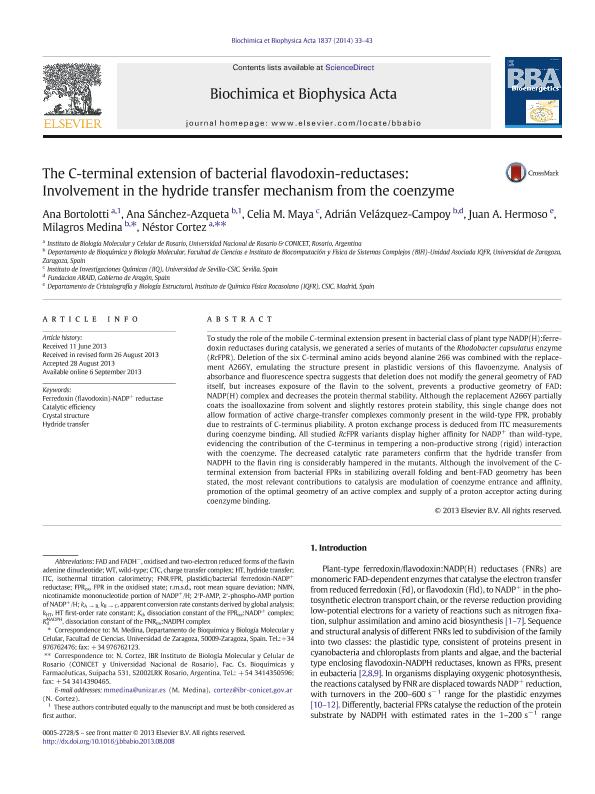Mostrar el registro sencillo del ítem
dc.contributor.author
Bortolotti, Ana

dc.contributor.author
Sánchez Azqueta, Ana
dc.contributor.author
Maya, Celia M.
dc.contributor.author
Velázquez Campoy, Adrian
dc.contributor.author
Hermoso, Juan A
dc.contributor.author
Medina, Milagros
dc.contributor.author
Cortez, Nestor Ricardo

dc.date.available
2017-12-05T14:01:18Z
dc.date.issued
2014-01
dc.identifier.citation
Bortolotti, Ana; Sánchez Azqueta, Ana; Maya, Celia M.; Velázquez Campoy, Adrian; Hermoso, Juan A; et al.; The C-terminal extension of bacterial flavodoxin-reductases: Involvement in the hydride transfer mechanism from the coenzyme; Elsevier Science; Biochimica Et Biophysica Acta-bioenergetics; 1837; 1; 1-2014; 33-43
dc.identifier.issn
0005-2728
dc.identifier.uri
http://hdl.handle.net/11336/29689
dc.description.abstract
To study the role of the mobile C-terminal extension present in bacterial class of plant type NADP(H):ferredoxin reductases during catalysis, we generated a series of mutants of the Rhodobacter capsulatus enzyme (RcFPR). Deletion of the six C-terminal amino acids beyond alanine 266 was combined with the replacement A266Y, emulating the structure present in plastidic versions of this flavoenzyme. Analysis of absorbance and fluorescence spectra suggests that deletion does not modify the general geometry of FAD itself, but increases exposure of the flavin to the solvent, prevents a productive geometry of FAD: NADP(H) complex and decreases the protein thermal stability. Although the replacement A266Y partially coats the isoalloxazine from solvent and slightly restores protein stability, this single change does not allow formation of active charge-transfer complexes commonly present in the wild-type FPR, probably due to restraints of C-terminus pliability. A proton exchange process is deduced from ITC measurements during coenzyme binding. All studied RcFPR variants display higher affinity for NADP+ than wild-type, evidencing the contribution of the C-terminus in tempering a non-productive strong (rigid) interaction with the coenzyme. The decreased catalytic rate parameters confirm that the hydride transfer from NADPH to the flavin ring is considerably hampered in the mutants. Although the involvement of the Cterminal extension from bacterial FPRs in stabilizing overall folding and bent-FAD geometry has been stated, the most relevant contributions to catalysis are modulation of coenzyme entrance and affinity, promotion of the optimal geometry of an active complex and supply of a proton acceptor acting during coenzyme binding
dc.format
application/pdf
dc.language.iso
eng
dc.publisher
Elsevier Science

dc.rights
info:eu-repo/semantics/openAccess
dc.rights.uri
https://creativecommons.org/licenses/by-nc-sa/2.5/ar/
dc.subject
Ferredoxin (Flavodoxin)-Nadp+ Reductase
dc.subject
Catalytic Efficiency
dc.subject
Crystal Structure
dc.subject
Hydride Transfer
dc.subject.classification
Otras Ciencias Biológicas

dc.subject.classification
Ciencias Biológicas

dc.subject.classification
CIENCIAS NATURALES Y EXACTAS

dc.title
The C-terminal extension of bacterial flavodoxin-reductases: Involvement in the hydride transfer mechanism from the coenzyme
dc.type
info:eu-repo/semantics/article
dc.type
info:ar-repo/semantics/artículo
dc.type
info:eu-repo/semantics/publishedVersion
dc.date.updated
2017-12-04T19:17:21Z
dc.journal.volume
1837
dc.journal.number
1
dc.journal.pagination
33-43
dc.journal.pais
Países Bajos

dc.journal.ciudad
Amsterdam
dc.description.fil
Fil: Bortolotti, Ana. Consejo Nacional de Investigaciones Científicas y Técnicas. Centro Científico Tecnológico Conicet - Rosario. Instituto de Biología Molecular y Celular de Rosario. Universidad Nacional de Rosario. Facultad de Ciencias Bioquímicas y Farmacéuticas. Instituto de Biología Molecular y Celular de Rosario; Argentina
dc.description.fil
Fil: Sánchez Azqueta, Ana. Universidad de Zaragoza; España
dc.description.fil
Fil: Maya, Celia M.. Universidad de Sevilla; España
dc.description.fil
Fil: Velázquez Campoy, Adrian. Universidad de Zaragoza; España. Fundacion ARAID. Aragón; España
dc.description.fil
Fil: Hermoso, Juan A. Instituto de Química Física Rocasolano. Madrid; España
dc.description.fil
Fil: Medina, Milagros. Universidad de Zaragoza; España
dc.description.fil
Fil: Cortez, Nestor Ricardo. Consejo Nacional de Investigaciones Científicas y Técnicas. Centro Científico Tecnológico Conicet - Rosario. Instituto de Biología Molecular y Celular de Rosario. Universidad Nacional de Rosario. Facultad de Ciencias Bioquímicas y Farmacéuticas. Instituto de Biología Molecular y Celular de Rosario; Argentina
dc.journal.title
Biochimica Et Biophysica Acta-bioenergetics

dc.relation.alternativeid
info:eu-repo/semantics/altIdentifier/doi/http://dx.doi.org/10.1016/j.bbabio.2013.08.008
dc.relation.alternativeid
info:eu-repo/semantics/altIdentifier/url/http://www.sciencedirect.com/science/article/pii/S000527281300145
Archivos asociados
